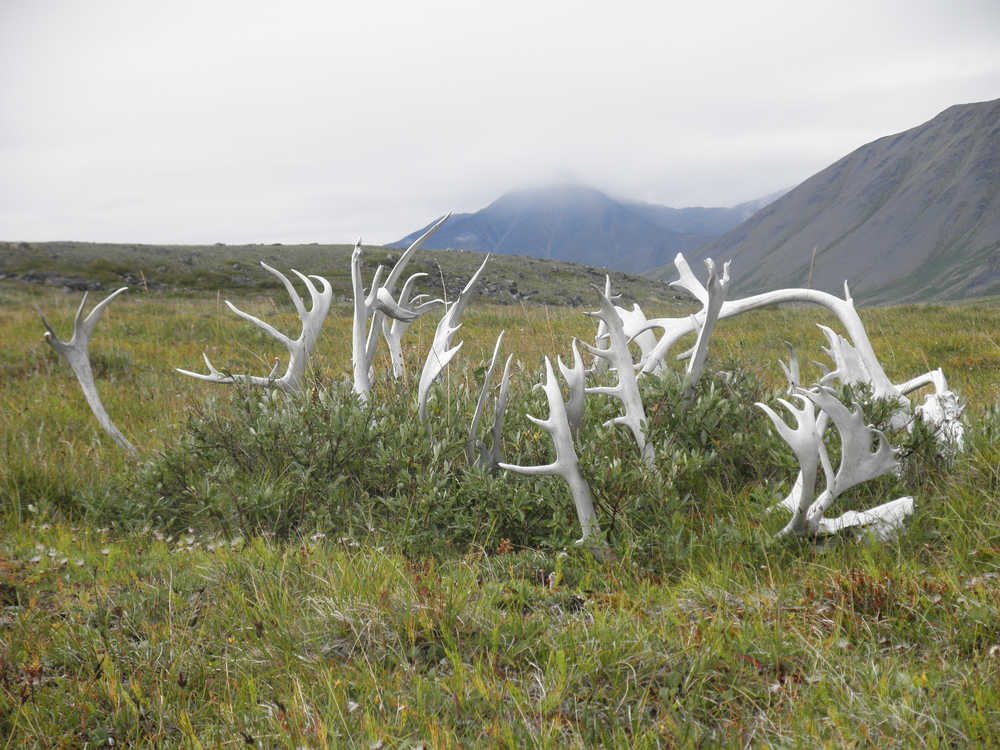Once, while camped in a valley in the Central Brooks Range, I dreamt I heard an old woman crying outside my tent. When I woke I couldn’t resist peering outside, but saw nothing besides snowy tundra and mountains in the darkness.
I lay in my sleeping bag remembering stories of starvation and of people being forced to abandon elderly people and children to survive.
The next day I found the tracks of four grizzly bears — two traveled alone and the other set belonged to a sow and cub — who all seemed to have woken from their winter slumber during the night.
I skied around 20 miles that day, at times following the fresh trail of one bear through wet snow, but never caught a glimpse of anything other than a few ptarmigan doing courtship displays.
Every river and many mountains in the Central Brooks Range have a Nunamiut name and story behind them. The Nunamiut are an inland Inupiaq people who depend on caribou and whose home for generations beyond memory is the Central Brooks Range. Simon Paneak called his home a “hungry country.” Paneak lived through years of starvation and the transition from living a nomadic life to settling in the Nunamiut village of Anaktuvuk Pass.
Near the end of the 1800s, with the arrival of commercial whaling ships, explorers and missionaries to the Arctic Ocean, came drastic change. Disease and alcohol devastated the northern peoples’ population. New trade items remodeled bartering and subsistence patterns. At the turn of the 20th century, with the dissappearance of caribou, the Nunamiut starved and were forced to join their coastal cousins, or migrate hundreds of miles into Canada where caribou populations remained healthy.
Archeologists estimate the population of the Nunamiut at around a thousand before contact with Euro-Americans. Shortly after commercial whalers arrived, the population shrunk to around 100.
In the late 1930s with the collapse of the fur industry and a recovering population of caribou, a handful of disenchanted Nunamiut families left the coast and returned to the central Brooks Range. They lived much as they had for hundreds years: moving across the country, harvesting with the seasons, cut off from and virtually unknown to the rest of the world.
They built dead-fall traps to kill small mammals, snared ptarmigan, sewed caribou skin tents, wove fish nets, killed wolves for bounty and, as they had for centuries, hunted caribou.
Years elapsed, and the different Nunamiut families to settle into the mountain pass separating the Anaktuvuk River from the John River. Anaktuvuk Pass became the furthest inland Inupiaq village in Alaska. A post office was established in 1951, followed shortly by trading post and, then, a Presbyterian church in 1958, and a permanent school in 1961.
On another trip into the Central Brooks Range, I found a lost and near-starving Nunamiut man. I gave him clothes, food and together we walked for a day and a half until we ran into two Anaktuvuk Pass men on four-wheelers. They took my companion home and left me with a bag of boiled caribou meat.
A day later I walked past caribou skulls, antlers and broken down snow machines as I neared the sprawl of plywood, tin-roofed, satellite-dish adorned homes of Anaktuvuk Pass. I walked out of town with a Monster energy drink and a fistful of dried caribou meat.
People were busy hunting caribou as I walked down the John River Valley. They stopped on their argos and four-wheelers for conversation, to warn me about aggressive grizzlies and give me caribou meat. The last hunter I talked to tried to get me take an entire uncooked hind-quarter. I felt rude, but I declined — with all the bears, I didn’t want blood on my pack. Instead, he passed me half of a boiled pelvis.
I walked past the last of the hunters and up Ekopuk Creek. Coming across a small gravel rise, I noticed a circle of stones large enough to hold down the edges of a caribou skin tent. The sort of homes the Nunamiut and other Arctic people used for hundreds, even thousands of years.
Weathered antlers and bones lay nearby. I sat outside the circle, gnawing on the meat from the pelvis. Part of me wanted to step within the stones, to feel where people once sat and rested, to smell the lichens and gravel, to listen for a faint whispering of lives vastly different than my own.
But I was not them, and the idea of crossing into the circle felt invasive, even sacrilegious.
I put a hand on one of the stones, and listened to the flow of the creek rippling and the pulsations beating through the gentle stillness. I gnawed the rest of the meat off the pelvis, tossed it next to the ancient caribou bones and continued up the valley.
For more on the history of the Nunamiut, check out Simon Paneak’s book of essays “In a Hungry Country” transcribed and edited by John Martin Campbell.
• Bjorn Dihle is a Juneau writer. He can be reached at bjorndihle@yahoo.com.

